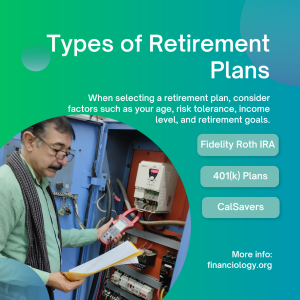What retirement plan is best for me?
11 min read
Navigating Retirement Planning:
Discovering the Ideal Retirement Plan for You!
Explore the diverse landscape of retirement plans to find the perfect fit for your financial future. Learn about different options and factors to consider in determining what retirement plan is best for you.
Embarking on the journey of retirement planning can be both exciting and overwhelming. With many retirement plans available, it’s essential to discern which aligns best with your financial goals and lifestyle. So, what retirement plan is best for you? Let’s delve into the intricacies and options to help you make an informed decision.
1. 401(k) Plans:
- Ideal for employees of companies offering this benefit.
- Enjoy tax advantages and potential employer-matching contributions.
- Contributions are deducted directly from your paycheck, fostering disciplined saving habits.
2. Individual Retirement Accounts (IRAs):
- Suitable for individuals without access to employer-sponsored plans.
- Choose between Traditional and Roth IRAs based on tax preferences.
- Offers a wide range of investment options, empowering you to customize your portfolio.
3. Roth 401(k) or Roth IRA:
- Optimal for those anticipating higher tax brackets in retirement.
- Contributions are made after-tax, allowing tax-free withdrawals in retirement.
- Ideal for young professionals or individuals with long-term growth potential.
4. Self-Employed Retirement Plans:
- Tailored solutions for entrepreneurs and freelancers.
- Options include Solo 401(k)s, SEP-IRAs, and SIMPLE IRAs.
- Enjoy higher contribution limits and potential tax benefits.
5. Pension Plans:
- Commonly offered by government entities and certain employers.
- Provides a fixed income stream in retirement, offering stability and security.
- Contributions are typically made by the employer, easing financial responsibility.
6. Health Savings Accounts (HSAs):
- Supplemental retirement option for individuals with high-deductible health plans.
- Triple tax advantages: contributions are tax-deductible, earnings grow tax-free, and withdrawals for qualified medical expenses are tax-free.
- Unused funds can be rolled over annually, making it a valuable long-term asset.
When determining the best retirement plan for you, consider factors such as your age, income level, risk tolerance, and retirement goals. Additionally, evaluate each plan’s contribution limits, tax implications, investment options, and withdrawal restrictions.
Consulting with a financial advisor can provide personalized guidance tailored to your specific needs and circumstances. They can help navigate the complexities of retirement planning, optimize your investment strategy, and ensure you’re on track to achieve your retirement dreams.
The best retirement plan for you is one that aligns with your financial objectives, risk tolerance, and lifestyle preferences. By exploring the options available and seeking professional advice, you can embark on your retirement journey with confidence and peace of mind. Start retirement planning today to secure a prosperous future tomorrow.
A Beginner’s Guide:

How to Start a Solo 401k Plan for Your Retirement?
Ready to take control of your retirement savings? Learn step-by-step how to start a Solo 401k plan, tailored for self-employed individuals and small business owners. Explore eligibility, benefits, contribution limits, and key considerations to maximize your retirement nest egg.
Are you a self-employed individual or a small business owner looking to supercharge your retirement savings? A Solo 401k plan could be the perfect solution for you. Designed specifically for sole proprietors and small businesses without employees (except a spouse), this retirement plan offers flexibility, tax advantages, and the potential for substantial contributions. Let’s explore how to start a Solo 401(k) plan in simple, actionable steps.
- Understand Eligibility: Determine if you qualify for a Solo 401k plan. Eligible individuals include self-employed individuals, sole proprietors, freelancers, and small business owners with no full-time employees (except a spouse).
- Choose a Provider: Research and select a reputable financial institution or provider offering Solo 401(k) plans. Consider factors such as fees, investment options, customer service, and plan features.
- Complete Plan Documents: Work with your chosen provider to complete the necessary plan documents. This typically includes an adoption agreement and a basic plan document outlining the terms and conditions of your Solo 401k plan.
- Establish the Plan: Once the plan documents are finalized, establish the Solo 401(k) plan by opening an account with your chosen provider. Provide any required information and documentation to set up the plan.
- Elect Plan Features: Customize your Solo 401k plan by electing specific features such as contribution types (traditional or Roth), investment options, and loan provisions. Tailor the plan to align with your retirement goals and risk tolerance.
- Make Contributions: Start contributing to your Solo 401k plan. As both the employer and employee, you have the opportunity to make generous contributions, potentially maximizing your retirement savings compared to other retirement plans.
- Stay Compliant: Familiarize yourself with the rules and regulations governing Solo 401(k) plans to ensure compliance. Stay informed about contribution limits, distribution rules, and any reporting requirements to avoid penalties or audits.
- Monitor and Manage: Regularly review and adjust your Solo 401k plan as needed. Monitor investment performance, adjust contributions based on your financial situation, and stay proactive in managing your retirement savings.
Starting a Solo 401k plan offers self-employed individuals and small business owners a powerful tool to save for retirement while enjoying tax advantages and investment flexibility. By following these steps and seeking guidance from financial professionals if needed, you can embark on your journey to a secure and prosperous retirement.
Remember, the key to a successful retirement plan is starting early, contributing consistently, and staying informed about your investment options. Take control of your financial future today by initiating your Solo 401k plan and laying the foundation for a comfortable retirement tomorrow.
Demystifying Fidelity Investments Roth IRA
A Comprehensive Guide: Curious about Fidelity Investments Roth IRA? Discover what it is, how it works, and why it could be a valuable addition to your retirement portfolio. Explore key features, benefits, investment options, and considerations to make informed decisions about your financial future.
If you’re on the quest for retirement planning options, you may have come across the term “Fidelity Investments Roth IRA.” But what exactly is it, and how does it fit into your retirement strategy? Let’s dive into the details to demystify this popular retirement plan.
Understanding Fidelity Investments Roth IRA
1. What is a Roth IRA?
- A Roth IRA is a retirement savings account that offers tax-free growth and tax-free withdrawals in retirement. Unlike traditional IRAs, contributions to a Roth IRA are made with after-tax dollars, meaning you won’t get an immediate tax deduction. However, qualified withdrawals, including earnings, are tax-free in retirement.
2. Introduction to Fidelity Investments:
- Fidelity Investments is a leading financial services firm known for its comprehensive range of investment products, retirement planning solutions, and robust customer support. Fidelity offers a variety of retirement accounts, including Roth IRAs, tailored to meet the diverse needs of investors.
3. Features and Benefits of Fidelity Investments Roth IRA:
- Tax-Free Growth: Enjoy the potential for tax-free growth on your investments, allowing your retirement savings to compound over time without the burden of taxes.
- Flexible Investment Options: Access a wide range of investment choices, including mutual funds, exchange-traded funds (ETFs), stocks, bonds, and more, to build a diversified portfolio aligned with your risk tolerance and investment objectives.
- No Required Minimum Distributions (RMDs): Unlike traditional IRAs, Roth IRAs do not have required minimum distributions (RMDs) during the account owner’s lifetime, providing greater flexibility in managing your retirement income.
- Potential Estate Planning Benefits: Roth IRAs offer potential estate planning benefits, as qualified distributions to beneficiaries are also tax-free, providing a legacy for future generations.
– Contribution Flexibility: Roth IRAs allow for flexible contributions, with annual contribution limits set by the IRS. Additionally, individuals may be eligible to contribute to a Roth IRA regardless of age, as long as they have earned income within certain limits.
4. Considerations Before Opening a Fidelity Investments Roth IRA:
- Eligibility: Ensure you meet the eligibility criteria for opening a Roth IRA, including income limits set by the IRS.
- Investment Strategy: Define your investment strategy and risk tolerance to select suitable investment options within your Roth IRA.
- Long-Term Financial Goals: Evaluate how a Fidelity Investments Roth IRA aligns with your long-term financial goals and retirement objectives.
Fidelity Investments Roth IRA offers a compelling option for retirement savers seeking tax-efficient growth and flexibility in their retirement planning journey.
By understanding its features, benefits, and considerations, you can make informed decisions about incorporating a Fidelity Investments Roth IRA into your retirement portfolio and working towards a financially secure future.
Recent blogs:
- A Comprehensive Guide to Retirement Plans
- Understanding The Federal Student Loans Types
- A Guide to Consolidating Graduate Student Loans
- Leading Universities in the World
- Review of Princeton University
- Zurich Institute of Technology
Unveiling Gold IRAs: A Guide to Diversifying Your Retirement Portfolio

Explore the concept of Gold IRAs as a retirement plan option. Learn what Gold IRAs are, their benefits, how they work, and considerations for integrating them into your retirement strategy. Discover how adding precious metals to your portfolio can enhance diversification and safeguard your retirement savings.
In the realm of retirement planning, diversification is key to building a resilient portfolio that can weather market volatility and economic uncertainties. One avenue for diversification that has garnered attention is Gold IRAs. But what exactly are Gold IRAs, and how can they enhance your retirement plan? Let’s delve into the details to uncover the potential benefits and considerations of incorporating Gold IRAs into your retirement strategy.
Understanding Gold IRAs:
1. What are Gold IRAs?
- Gold IRAs, or Gold Individual Retirement Accounts, are self-directed retirement accounts that allow investors to hold precious metals, such as gold, silver, platinum, and palladium, as part of their retirement portfolio. Unlike traditional IRAs or 401(k) plans, which typically invest in stocks, bonds, and mutual funds, Gold IRAs offer exposure to physical assets, providing a hedge against inflation and currency devaluation.
2. How do Gold IRAs Work?
- To establish a Gold IRA, investors must work with a custodian or trustee specializing in self-directed IRAs. The custodian facilitates the purchase and storage of precious metals on behalf of the account holder. The metals are held in a secure depository approved by the IRS, ensuring compliance with IRS regulations governing IRA investments.
- Investors have the flexibility to choose from a variety of precious metals products, including bullion coins, bars, and numismatic coins, to build their Gold IRA portfolio. It’s essential to conduct thorough research and seek guidance from reputable dealers to make informed investment decisions.
3. Benefits of Gold IRAs:
- Diversification: Gold IRAs offer diversification benefits by adding an alternative asset class to your retirement portfolio. Precious metals have historically exhibited a low correlation with traditional financial assets, providing a hedge against market downturns and economic instability.
- Inflation Hedge: Gold has long been recognized as a hedge against inflation and currency depreciation. Investing in gold through a Gold IRA can help preserve purchasing power and safeguard retirement savings against the erosive effects of inflation.
- Portfolio Protection: Gold IRAs provide portfolio protection in times of geopolitical uncertainty, financial crises, or currency devaluation. The intrinsic value and scarcity of gold make it a sought-after haven asset during turbulent times.
4. Considerations for Gold IRAs:
- Custodial Fees: Be mindful of custodial fees associated with maintaining a Gold IRA, including storage fees, administrative fees, and transaction costs. Compare fees among different custodians to ensure cost-effective management of your account.
- Market Volatility: While gold is often perceived as a haven asset, it is not immune to price fluctuations and market volatility. Consider your risk tolerance and investment horizon when incorporating gold into your retirement portfolio.
- Tax Implications: Understand the tax implications of holding precious metals within a retirement account. Withdrawals from Gold IRAs may be subject to taxation, depending on the type of account and distribution strategy.
Gold IRAs offer a compelling option for retirement savers seeking to diversify their portfolios and mitigate risk. By understanding the fundamentals of Gold IRAs, assessing their benefits and considerations, and consulting with financial professionals if needed, you can make informed decisions about integrating precious metals into your retirement plan. Start exploring the potential of Gold IRAs today and fortify your path to a secure and prosperous retirement.
Demystifying CalSavers:

A Beginner’s Guide to California’s Retirement Plan
Curious about the CalSavers retirement plan? Discover what it is, how it works, and why it could be a valuable tool for your financial future. Explore eligibility, features, benefits, and considerations to make informed decisions about your retirement savings in California.
In the landscape of financial planning, securing a comfortable retirement is paramount. For residents of California, one retirement plan option worth exploring is Cal Savers. But what exactly is Cal Savers, and how can it help you achieve your retirement goals? Let’s unravel the mysteries surrounding this retirement plan and understand its potential benefits and considerations.
Understanding Cal Savers:
1. What is CalSavers?
- Cal Savers is a state-sponsored retirement savings program designed to provide a retirement savings option for workers in California who do not have access to employer-sponsored retirement plans, such as 401(k) or 403(b) plans. It offers a convenient and accessible way for employees to save for retirement through automatic payroll deductions.
2. How does CalSavers Work?
- Employers with five or more employees who do not offer a qualified retirement plan are required by law to facilitate CalSavers for their employees. Employees are automatically enrolled in CalSavers unless they opt out. Contributions are made through payroll deductions and invested in a default investment option chosen by the program administrator, currently managed by Ascensus.
3. Features and Benefits of CalSavers:
- Accessibility: CalSavers provides a retirement savings option for employees of eligible businesses who may not have access to employer-sponsored retirement plans.
- Automatic Enrollment: Employees are automatically enrolled in CalSavers unless they choose to opt-out, making it easy to start saving for retirement.
- Portability: Participants can take their CalSavers account with them if they change jobs, providing continuity in their retirement savings journey.
- Low Fees: CalSavers offers a range of investment options with competitive fees, helping participants maximize their retirement savings without incurring excessive costs.
4. Eligibility and Considerations:
- Eligible Participants: CalSavers is available to employees of eligible employers who do not offer a qualified retirement plan, such as 401(k) or 403(b) plans. Self-employed individuals and independent contractors are not eligible to participate.
- Contribution Limits: Participants can contribute up to IRS annual contribution limits, which are subject to change each year. It’s essential to stay informed about current contribution limits to maximize your retirement savings.
- Investment Options: While CalSavers offers a default investment option, participants have the flexibility to choose from a variety of investment options based on their risk tolerance and investment objectives.
In conclusion, Cal Savers offers a valuable retirement savings option for workers in California who do not have access to employer-sponsored retirement plans.
By understanding CalSavers features, benefits, eligibility criteria, and considerations, individuals can make informed decisions about participating in CalSavers and taking control of their financial future. Explore the possibilities of CalSavers today and embark on the path to a secure and prosperous retirement tomorrow.






